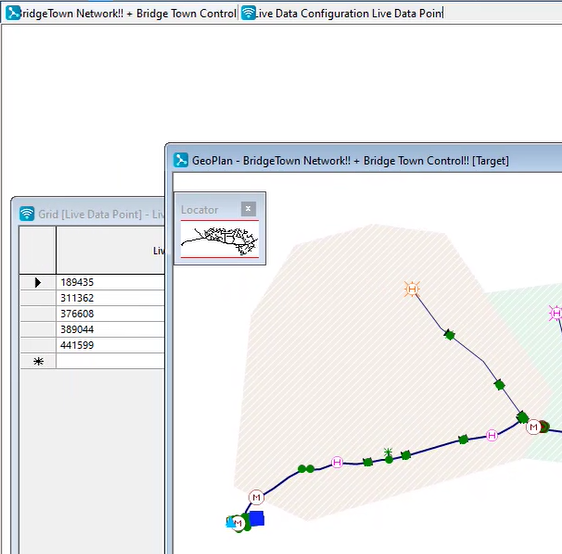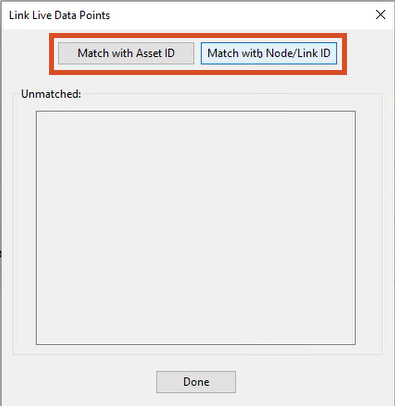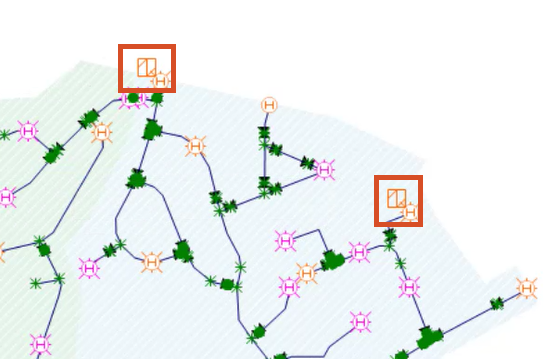& Construction

Integrated BIM tools, including Revit, AutoCAD, and Civil 3D
& Manufacturing

Professional CAD/CAM tools built on Inventor and AutoCAD
Transcript
00:03
Once you have entered the required information in the Live Data Configuration grid,
00:08
you must link it to the network.
00:10
This will show you the locations of the live data points within the network.
00:15
In the Model Group window, right-click Live Data Configuration
00:19
and commit any changes you have made to the database.
00:22
In this example, the changes are validated with no errors.
00:27
Then, open the network and its associated control in the GeoPlan.
00:32
To link the live data to your network, you must have the Live Data Configuration grid window open in the background of the workspace
00:40
with the network and control GeoPlan window in the foreground.
00:44
Note that if the window positions are reversed, or one is not open in the workspace,
00:49
you will not be able to link the live data to the network.
00:53
Now you need to check to make sure the live data points match with the nodes in the GeoPlan.
00:59
In the Network ribbon, click Control and from the flyout, select Link live data points...
01:06
to open the Link Live Data Points dialog.
01:09
Click both the Match with Asset ID and Match with Node/Link ID buttons.
01:16
In this example, nothing is listed in the Unmatched: group box,
01:20
meaning everything is correctly matched.
01:22
Click Done.
01:24
In the GeoPlan, notice that next to some objects,
01:28
there are now icons that look like an orange square with a slightly tilted “Z” inside.
01:34
This icon indicates that there is now a live data point attached to that object.
01:40
Optionally, you can right-click the GeoPlan and click Selection > Select live data point objects from the submenu.
01:47
This will select and highlight all the objects with live data attached to them, so they are easier to see.
01:54
In the toolbar, click the Clear selection button.
01:58
Commit any outstanding changes to the network and control to the database.
00:03
Once you have entered the required information in the Live Data Configuration grid,
00:08
you must link it to the network.
00:10
This will show you the locations of the live data points within the network.
00:15
In the Model Group window, right-click Live Data Configuration
00:19
and commit any changes you have made to the database.
00:22
In this example, the changes are validated with no errors.
00:27
Then, open the network and its associated control in the GeoPlan.
00:32
To link the live data to your network, you must have the Live Data Configuration grid window open in the background of the workspace
00:40
with the network and control GeoPlan window in the foreground.
00:44
Note that if the window positions are reversed, or one is not open in the workspace,
00:49
you will not be able to link the live data to the network.
00:53
Now you need to check to make sure the live data points match with the nodes in the GeoPlan.
00:59
In the Network ribbon, click Control and from the flyout, select Link live data points...
01:06
to open the Link Live Data Points dialog.
01:09
Click both the Match with Asset ID and Match with Node/Link ID buttons.
01:16
In this example, nothing is listed in the Unmatched: group box,
01:20
meaning everything is correctly matched.
01:22
Click Done.
01:24
In the GeoPlan, notice that next to some objects,
01:28
there are now icons that look like an orange square with a slightly tilted “Z” inside.
01:34
This icon indicates that there is now a live data point attached to that object.
01:40
Optionally, you can right-click the GeoPlan and click Selection > Select live data point objects from the submenu.
01:47
This will select and highlight all the objects with live data attached to them, so they are easier to see.
01:54
In the toolbar, click the Clear selection button.
01:58
Commit any outstanding changes to the network and control to the database.
Once the required information has been entered into the Live Data Configuration grid, it must be linked to the network. This shows the locations of live data points within the network.
IMPORTANT: If the window positions are reversed, or if one is not open in the workspace, you will not be able to link the live data to the network.

To make sure the live data points match with the nodes in the GeoPlan:

In this example, nothing is listed in the Unmatched: group box, meaning everything is correctly matched.
